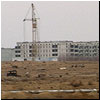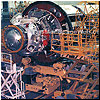| |
|
|
|
||||||||
|
History of launch facilities for the N1 moon rocket and the Energia super booster The construction of the launch complex dubbed "Raskat" (Roar) for the giant N1 Moon rocket officially started in Tyuratam in 1964, north of the original launch pad for the R-7 missile. (73) However, the active effort to build the complex did not commence until 1965. |
|||||||||
|
Site 110: Launch complex 11P825 Two launch pads at Site 110, known as "Left pad" and "Right pad" were built originally for the N1 Moon rocket. In the mid-1970, they were refurbished for the Energia-Buran system. The launch vehicle with the reusable orbiter would be rolled out to the launch pad on a 2,756-ton transporter-erector. |
|||||||||
|
Site 112 and 112A: Processing complexes 11P591 and 11P593 The original processing and assembly building for the N1 Moon rocket was refurbished for the Energia-Buran project in mid-1970s. In 2002, the roof of the main assembly halls at Site 112 collapsed destroying the historic Buran orbiter, which made a single flight in 1988. |
|||||||||
 |
Site 113: Forgotten lunar town of Baikonur The plans to assemble the N1 Moon rocket right at the launch site meant that thousands of workers and engineers would have to be deployed in the inhospitable steppes of Kazakhstan. So, in addition to the monumental assembly and launch infrastructure of the Moon Race, an entire city was founded at the heart of the Tyuratam test range, for the sole purpose of lunar conquest. |
||||||||
|
Site 250 and 250A: Test-firing stand/Launch complex 17P31 for Energia rocket A single most impressive launch complex in Baikonur was build for live firings of Energia's main engines. Separated to a safe distance from all other major facilities of Baikonur, Site 250 also hosted the first test launch of the Energia rocket in 1987. At the turn of the 21st century, the Russian government offered Kazakhstan to fund the conversion of the site into the Baiterek complex designed for joint missions of the Angara rocket. |
|||||||||
|
Site 251: Buran landing facility 11P72 (Yubileiny airport) By mid-1980s, a new airport was completed on the northern fringes of Baikonur Cosmodrome to serve as a primary landing site for Buran. With the demise of the program, the facility eventually became an entry point for much of the commercial cargo entering the space center, including many communications satellites, destined to ride Russian rockets into orbit. |
|||||||||
|
Site 254: Buran processing facility A special four-bay building was erected at Site 254 in Baikonur to service the Buran orbiter between flights. This unique structure is 312 meters long and 254 meters wide, covering some 72,000 square meters. The main processing area inside the building is flanked by four floors of various test rooms with the total 4,800 square meters of space. |
|||||||||
 |
Processing for Nauka module at Site 254 (INSIDER CONTENT) The delivery of the Nauka module to Baikonur Cosmodrome in August 2020 marked the beginning of the launch campaign for the 20-ton spacecraft. It was the first time in two decades that the Russian personnel in Kazakhstan had to work with the a space station module of this size and complexity. To complete the task, a dedicated preparation facility was deployed inside the former Buran processing building at Site 254. |
||||||||
| MULTIMEDIA | |||||||||
 |
This
360-degree panorama provides a unique look at the central region of the
Baikonur Cosmodrome occupied by the Energia-Buran facilities:
|
||||||||